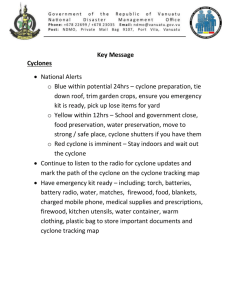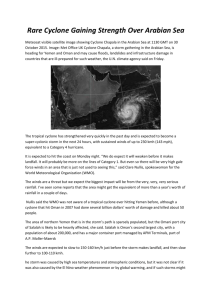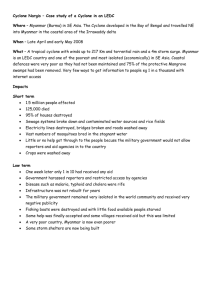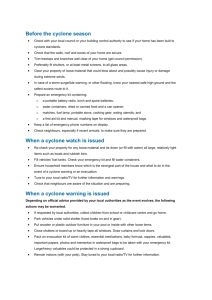Cyclone - The Department of Education and Training
advertisement
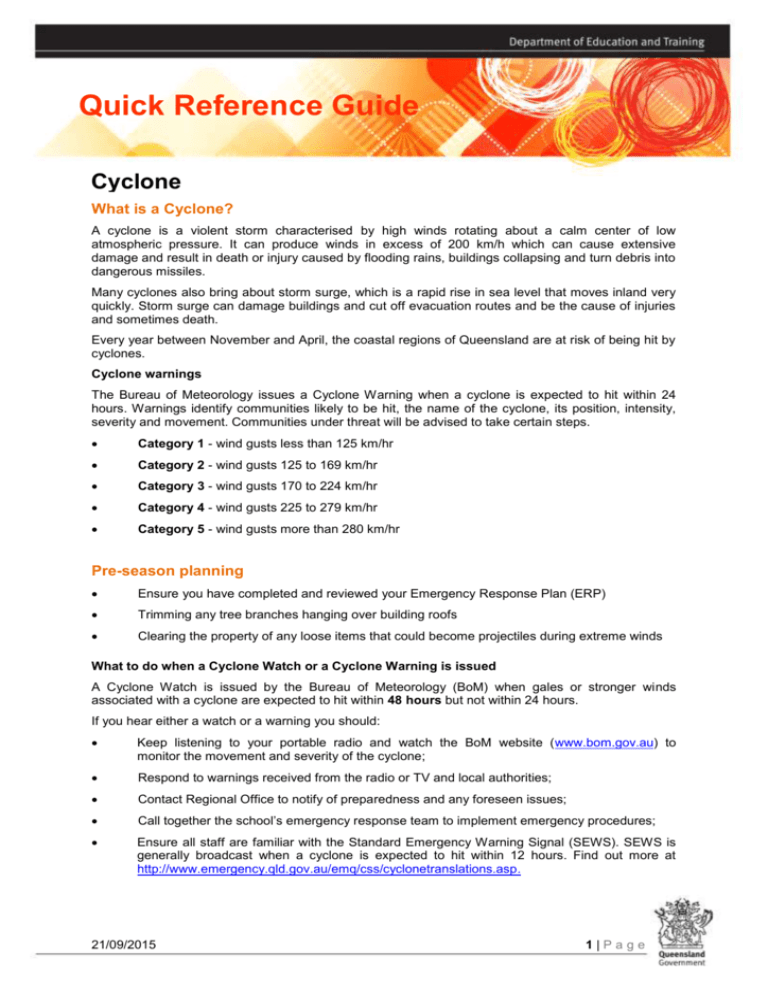
Quick Reference Guide Cyclone What is a Cyclone? A cyclone is a violent storm characterised by high winds rotating about a calm center of low atmospheric pressure. It can produce winds in excess of 200 km/h which can cause extensive damage and result in death or injury caused by flooding rains, buildings collapsing and turn debris into dangerous missiles. Many cyclones also bring about storm surge, which is a rapid rise in sea level that moves inland very quickly. Storm surge can damage buildings and cut off evacuation routes and be the cause of injuries and sometimes death. Every year between November and April, the coastal regions of Queensland are at risk of being hit by cyclones. Cyclone warnings The Bureau of Meteorology issues a Cyclone Warning when a cyclone is expected to hit within 24 hours. Warnings identify communities likely to be hit, the name of the cyclone, its position, intensity, severity and movement. Communities under threat will be advised to take certain steps. Category 1 - wind gusts less than 125 km/hr Category 2 - wind gusts 125 to 169 km/hr Category 3 - wind gusts 170 to 224 km/hr Category 4 - wind gusts 225 to 279 km/hr Category 5 - wind gusts more than 280 km/hr Pre-season planning Ensure you have completed and reviewed your Emergency Response Plan (ERP) Trimming any tree branches hanging over building roofs Clearing the property of any loose items that could become projectiles during extreme winds What to do when a Cyclone Watch or a Cyclone Warning is issued A Cyclone Watch is issued by the Bureau of Meteorology (BoM) when gales or stronger winds associated with a cyclone are expected to hit within 48 hours but not within 24 hours. If you hear either a watch or a warning you should: Keep listening to your portable radio and watch the BoM website (www.bom.gov.au) to monitor the movement and severity of the cyclone; Respond to warnings received from the radio or TV and local authorities; Contact Regional Office to notify of preparedness and any foreseen issues; Call together the school’s emergency response team to implement emergency procedures; Ensure all staff are familiar with the Standard Emergency Warning Signal (SEWS). SEWS is generally broadcast when a cyclone is expected to hit within 12 hours. Find out more at http://www.emergency.qld.gov.au/emq/css/cyclonetranslations.asp. 21/09/2015 1|Page Preparedness prior to the event Review and update your ERP Secure buildings, furniture, equipment, chemicals, fuels and other facilities Turning off gas and electricity supplies (where impact is imminent) Checking fuel for generators (if applicable) Keeping a list of emergency numbers on hand including Regional Office, BAS and ESMU Keeping a list of student and staff contact information Ensure everyone knows how to ‘Tune into Warnings’ Tune in to your local radio and TV station Log on to the Bureau of Meteorology website Listen out to Emergency Alert messages sent to your phone Act! - Warnings are urgent. Act immediately on the advice provided. Immediate action Activate your Emergency Response Plan (ERP) Consider School closure as per CE Directive No.01/2015 Follow up actions Do not use matches or lighters, in case of leaking natural gas pipes or fuel tanks nearby Remain calm and alert, and listen for information and instructions from emergency services or local officials Contact your Regional Director Refer media to the Regional Director Consider school closure CE Directive No.01/2015 Engage communications strategy Check with local councils for boiled water alerts Confirm power is connected Check that sewage services are operational If damage to facilities or debris on site, contact BAS immediately to respond to the clean-up and rectification works For support on any of the above, please contact your Regional Office Infrastructure Advisor Notify Education Queensland International if any international student is involved 21/09/2015 2|Page Recovery Seek support from School Guidance Officers and Employee Advisors as appropriate: http://education.qld.gov.au/health/contacts/contacts-ea.html Review of processes, debriefing, and memorials (if necessary). NB: School closures are posted on DET website http://deta.qld.gov.au/natural-disasters.html, Facebook and Twitter. Additional Information For further information contact the Emergency and Security Management Unit on (07) 3034 6012 DET Website http://deta.qld.gov.au/ Twitter www.twitter.com/QLDDETE Facebook http://www.facebook.com/pages/Queensland-Department-of-Education-Training-andEmployment/136384799716300 21/09/2015 3|Page




